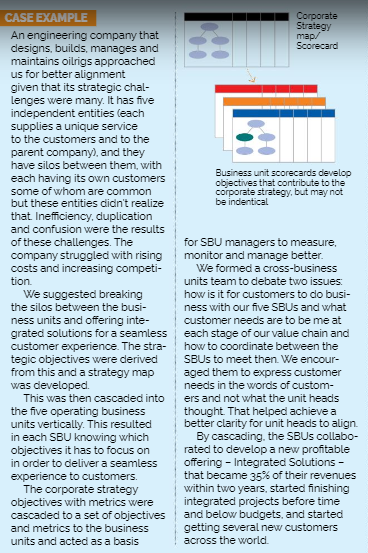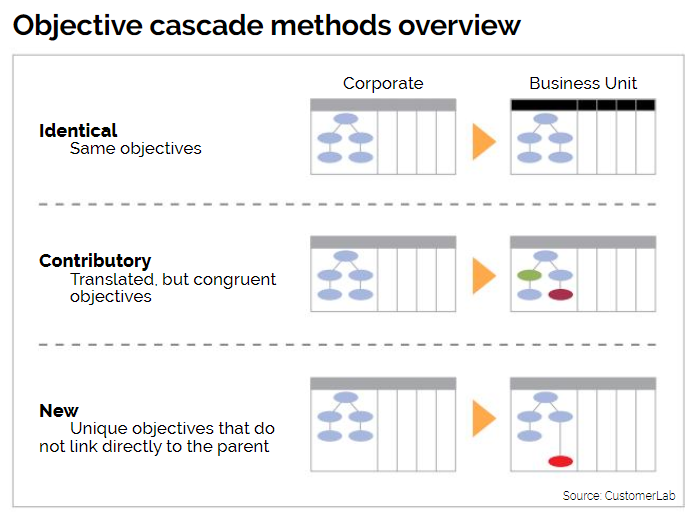Aligning SBUs with corporate strategy

While strategy gets formulated at the top, it gets executed at the bottom. It is also important that leadership team engages business heads, support unit heads and other stakeholders for the success of the enterprise strategy. Without alignment of all these different groups with the enterprise strategy, it is not possible to drive execution excellence.
When nine out of ten organizations fail to achieve their internally set objectives, it is clear that leadership teams have failed in getting horizontal and vertical alignment within. This is all the more challenging in a post-corona economy, which brings in many more challenges, and there is nothing more important than your strategy and its meticulous execution.
When everyone understands his or her role in executing the strategy, and when business unit leaders create synergies – unexpected opportunities to generate results that benefit the participating units and the overall organization, true alignment is achieved. I am sharing, for the first time, the secrets of achieving alignment, based on years of work at various organizations globally.
Most CEOs do not understand what it takes to bring in true alignment. In true alignment, each SBU supports the strategy of the unit above it and also the strategy of its peer units. Which means it is an activity that is both vertical and horizontal. Vertical alignment is when your SBU supports the strategy of the unit above you, and the units below yours support your unit. We do this through cascading of objectives. Horizontal alignment between peer units is achieved by integrating shared objectives. I will present practical steps for vertical alignment in this column and the horizontal alignment techniques in the next.
We use four stages to achieve vertical alignment or cascading. First, we define the organizational position by clarifying where a business unit fits in horizontally and vertically. What is its relationship to the units below and above? Does it have to collaborate with any peer units? Second, we create an alignment action agenda to implement cascading and integration. Third, we use appropriate tools to action it and finally drive a communication plan to sustain the alignment efforts.

With alignment, leaders can create tremendous value for the organization in terms of building synergies, better resource utilization, deeper understanding of employee regular work to strategy and increased communication effectiveness.
An engineering company that designs, builds, manages and maintains oilrigs approached us for better alignment given that its strategic challenges were many. It has five independent entities (each supplies a unique service to the customers and to the parent company), and they have silos between them, with each having its own customers some of whom are common but these entities didn’t realize that. Inefficiency, duplication and confusion were the results of these challenges. The company struggled with rising costs and increasing competition.
We suggested breaking the silos between the business units and offering integrated solutions for a seamless customer experience. The strategic objectives were derived from this and a strategy map was developed.
This was then cascaded into the five operating business units vertically. This resulted in each SBU knowing which objectives it has to focus on in order to deliver a seamless experience to customers.
The corporate strategy objectives with metrics were cascaded to a set of objectives and metrics to the business units and acted as a basis for SBU managers to measure, monitor and manage better.
We formed a cross-business units team to debate two issues: how is it for customers to do business with our five SBUs and what customer needs are to be me at each stage of our value chain and how to coordinate between the SBUs to meet then. We encouraged them to express customer needs in the words of customers and not what the unit heads thought. That helped achieve a better clarity for unit heads to align.
By cascading, the SBUs collaborated to develop a new profitable offering – Integrated Solutions – that became 35% of their revenues within two years, started finishing integrated projects before time and below budgets, and started getting several new customers across the world.
Four stages to cascading
By cascading strategy map and scorecards to various levels, the top management can enable alignment of activities to the core strategic objectives of the higher units. That way, leaders at each level support the overall enterprise vision.

What's your organizational position?
Where does your SBU fit in the vertical chain of command? You can start with checking if your oganization resembles functionally singular or integrated, or purely a fund allocator. Which business units do you report to and which ones report to you?
Check also for similar role business units. Whether they are like the branches of a bank or completely different roles based on lines of business.
The above diagram will give you an idea on the position of organization and possible cascading method, with indicative examples.
What's your action plan?
An action plan to cascade should cover the following: Intended time frame by which the cascading of scorecards should be completed, the way in which the subordinate scorecards are made (one at a time or together?) and the degree of independence to be given to each SBU in developing the cascaded scorecards.
In any case, the following elements of the scorecards are mandatory for all subordinate ones: themes, objectives, metrics and initiatives that are handed down from the enterprise strategy along with some elements of corporate values, etc.
What techniques to use?
What best cascading technique is suited for the cascading depends on the process of identifying mandatory elements required for each Strategic Business Unit (SBU) and subunits. The three techniques we use are Shared, Contributory and Hybrid, and each of these will have the cascading as shown in the above picture.
In the shared technique, typically if you are a bank or hotel, the objectives at the corporate level will be almost identical and will be mandatory. For example, most of the objectives and metrics of a hotel group like the Taj will be shared across its various properties but targets will vary.
In the contributory technique, each cascaded scorecard contains translated but congruent objectives that clearly support the larger enterprise objective.
This technique is used when fewer scorecard elements have been mandated, but the higher organization still wants to enforce clear lines of alignment. An example of a translated objective is an HR scorecard. HR contributes to the overall business objective of “retain high performance talent” through an internal process objective called "recruit quality employees.” This objective provides a much more specific description of how HR contributes.
In the hybrid technique, some objectives are shared with those on the larger enterprise's scorecard. Others are not identical, but are translated, or new customized for the SBU. The hybrid technique is used when very few scorecard elements have been mandated. To support a corporate objective to “sustain the business”, HR may have an objective of “building excellence in training programs” while IT department may have “reducing downtime of systems” as an objective.

The above figure depicts a cascaded scorecard that has used all the techniques.
How do you sustain the cascading?
Formal communication up and down the enterprise will help sustain the vertical alignment efforts, and for this, common objectives between the enterprise and your SBU as well as yours and those of the subordinate business units will play a key role. Even if there is a leadership change, the continuity will not be lost.
The communication must be ongoing and systematic. When we work with clients, we provide guidance on holding periodic approval meetings and performance review meetings. In fact, we conduct a few of these meetings ourselves to make them form a habit.
In the approval meetings, which could be monthly or quarterly, we get the leaders directly one-above to ensure that the SBU’s scorecard continues to stay aligned with the enterprise scorecard. The review meetings are conducted with subordinate business units to ensure that their scorecards are aligned with the SBU and also to show commitment to the cascading process.
Cascading drives the enterprise to achieve alignment vertically. However, the horizontal alignment will require another process called Integration. Same-level business units within your enterprise can coordinate the objectives through integration and shared objectives, which we shall discuss in the next column.
















